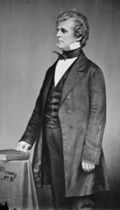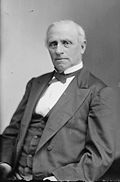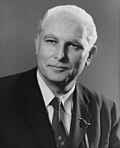| Member | Party | Years | Cong
ress | Electoral history | Location |
|---|
| District created March 4, 1837 |

Isaac Toucey
(Hartford) | Democratic | March 4, 1837 –
March 3, 1839 | 25th | Redistricted from the at-large district and re-elected in 1837.
Lost re-election. | |

Joseph Trumbull
(Hartford) | Whig | March 4, 1839 –
March 3, 1843 | 26th
27th | Elected in 1839.
Re-elected in 1840.
Retired. |

Thomas H. Seymour
(Hartford) | Democratic | March 4, 1843 –
March 3, 1845 | 28th | Elected in 1843.
Retired. |

James Dixon
(Hartford) | Whig | March 4, 1845 –
March 3, 1849 | 29th
30th | Elected in 1845.
Re-elected in 1847.
Retired. |

Loren P. Waldo
(Tolland) | Democratic | March 4, 1849 –
March 3, 1851 | 31st | Elected in 1849.
Lost re-election. |

Charles Chapman
(Hartford) | Whig | March 4, 1851 –
March 3, 1853 | 32nd | Elected in 1851.
Retired to run for Governor. |

James T. Pratt
(Rocky Hill) | Democratic | March 4, 1853 –
March 3, 1855 | 33rd | Elected in 1853.
Lost re-election. |

Ezra Clark Jr.
(Hartford) | American | March 4, 1855 –
March 3, 1857 | 34th
35th | Elected in 1855.
Re-elected in 1857.
Lost re-election. |
| Republican | March 4, 1857 –
March 3, 1859 |

Dwight Loomis
(Rockville) | Republican | March 4, 1859 –
March 3, 1863 | 36th
37th | Elected in 1859.
Re-elected in 1861.
Retired. |

Henry C. Deming
(Hartford) | Republican | March 4, 1863 –
March 3, 1867 | 38th
39th | Elected in 1863.
Re-elected in 1865.
Lost re-election. |

Richard D. Hubbard
(Hartford) | Democratic | March 4, 1867 –
March 3, 1869 | 40th | Elected in 1867.
Retired. |
Julius L. Strong
(Hartford) | Republican | March 4, 1869 –
September 7, 1872 | 41st
42nd | Elected in 1869.
Re-elected in 1871.
Died. |
| Vacant | September 7, 1872 –
December 2, 1872 | 42nd | |

Joseph Roswell Hawley
(Hartford) | Republican | December 2, 1872 –
March 3, 1875 | 42nd
43rd | Elected to finish Strong's term.
Re-elected in 1873.
Lost re-election. |

George M. Landers
(New Britain) | Democratic | March 4, 1875 –
March 3, 1879 | 44th
45th | Elected in 1875.
Re-elected in 1876.
Retired. |

Joseph Roswell Hawley
(Hartford) | Republican | March 4, 1879 –
March 3, 1881 | 46th | Elected in 1878.
Retired when elected U.S. Senator. |

John R. Buck
(Hartford) | Republican | March 4, 1881 –
March 3, 1883 | 47th | Elected in 1880.
Lost re-election. |

William W. Eaton
(Hartford) | Democratic | March 4, 1883 –
March 3, 1885 | 48th | Elected in 1882.
Lost re-election. |

John R. Buck
(Hartford) | Republican | March 4, 1885 –
March 3, 1887 | 49th | Elected in 1884.
Lost re-election. |

Robert J. Vance
(New Britain) | Democratic | March 4, 1887 –
March 3, 1889 | 50th | Elected in 1886.
Lost re-election. |

William E. Simonds
(Canton) | Republican | March 4, 1889 –
March 3, 1891 | 51st | Elected in 1888.
Lost re-election. |

Lewis Sperry
(Hartford) | Democratic | March 4, 1891 –
March 3, 1895 | 52nd
53rd | Elected in 1890.
Re-elected in 1892.
Lost re-election. |

E. Stevens Henry
(Rockville) | Republican | March 4, 1895 –
March 3, 1913 | 54th
55th
56th
57th
58th
59th
60th
61st
62nd | Elected in 1894.
Re-elected in 1896.
Re-elected in 1898.
Re-elected in 1900.
Re-elected in 1902.
Re-elected in 1904.
Re-elected in 1906.
Re-elected in 1908.
Re-elected in 1910.
Retired. |

Augustine Lonergan
(Hartford) | Democratic | March 4, 1913 –
March 3, 1915 | 63rd | Elected in 1912.
Lost re-election. |

P. Davis Oakey
(Hartford) | Republican | March 4, 1915 –
March 3, 1917 | 64th | Elected in 1914.
Lost re-election. |

Augustine Lonergan
(Hartford) | Democratic | March 4, 1917 –
March 3, 1921 | 65th
66th | Elected in 1916.
Re-elected in 1918.
Retired to run for U.S. Senator. |

E. Hart Fenn
(Wethersfield) | Republican | March 4, 1921 –
March 3, 1931 | 67th
68th
69th
70th
71st | Elected in 1920.
Re-elected in 1922.
Re-elected in 1924.
Re-elected in 1926.
Re-elected in 1928.
Retired. |

Augustine Lonergan
(Hartford) | Democratic | March 4, 1931 –
March 3, 1933 | 72nd | Elected in 1930.
Retired when elected to the US Senate |

Herman P. Kopplemann
(Hartford) | Democratic | March 4, 1933 –
January 3, 1939 | 73rd
74th
75th | Elected in 1932.
Re-elected in 1934.
Re-elected in 1936.
Lost re-election. |

William J. Miller
(Wethersfield) | Republican | January 3, 1939 –
January 3, 1941 | 76th | Elected in 1938.
Lost re-election. |

Herman P. Kopplemann
(Hartford) | Democratic | January 3, 1941 –
January 3, 1943 | 77th | Elected in 1940.
Lost re-election. |

William J. Miller
(Wethersfield) | Republican | January 3, 1943 –
January 3, 1945 | 78th | Elected in 1942.
Lost re-election. |

Herman P. Kopplemann
(Hartford) | Democratic | January 3, 1945 –
January 3, 1947 | 79th | Elected in 1944.
Lost re-election. |

William J. Miller
(Wethersfield) | Republican | January 3, 1947 –
January 3, 1949 | 80th | Elected in 1946.
Lost re-election. |

Abraham Ribicoff
(Hartford) | Democratic | January 3, 1949 –
January 3, 1953 | 81st
82nd | Elected in 1948.
Re-elected in 1950.
Retired to run for U.S. Senator. |

Thomas J. Dodd
(West Hartford) | Democratic | January 3, 1953 –
January 3, 1957 | 83rd
84th | Elected in 1952.
Re-elected in 1954.
Retired to run for U.S. Senator. |

Edwin H. May Jr.
(Wethersfield) | Republican | January 3, 1957 –
January 3, 1959 | 85th | Elected in 1956.
Lost re-election. |

Emilio Q. Daddario
(Hartford) | Democratic | January 3, 1959 –
January 3, 1971 | 86th
87th
88th
89th
90th
91st | Elected in 1958.
Re-elected in 1960.
Re-elected in 1962.
Re-elected in 1964.
Re-elected in 1966.
Re-elected in 1968.
Retired to run for Governor. |

William R. Cotter
(Hartford) | Democratic | January 3, 1971 –
September 8, 1981 | 92nd
93rd
94th
95th
96th
97th | Elected in 1970.
Re-elected in 1972.
Re-elected in 1974.
Re-elected in 1976.
Re-elected in 1978.
Re-elected in 1980.
Died. |
| Vacant | September 9, 1981 –
January 11, 1982 | 97th | |

Barbara B. Kennelly
(Hartford) | Democratic | January 12, 1982 –
January 3, 1999 | 97th
98th
99th
100th
101st
102nd
103rd
104th
105th | Elected to finish Cotter's term.
Re-elected in 1982.
Re-elected in 1984.
Re-elected in 1986.
Re-elected in 1988.
Re-elected in 1990.
Re-elected in 1992.
Re-elected in 1994.
Re-elected in 1996.
Retired to run for Governor. |

John B. Larson
(East Hartford) | Democratic | January 3, 1999 –
present | 106th
107th
108th
109th
110th
111th
112th
113th
114th
115th
116th
117th
118th
119th | Elected in 1998.
Re-elected in 2000.
Re-elected in 2002.
Re-elected in 2004.
Re-elected in 2006.
Re-elected in 2008.
Re-elected in 2010.
Re-elected in 2012.
Re-elected in 2014.
Re-elected in 2016.
Re-elected in 2018.
Re-elected in 2020.
Re-elected in 2022.
Re-elected in 2024. | |
2003–2013  |
2013–2023  |
2023–present  |



































